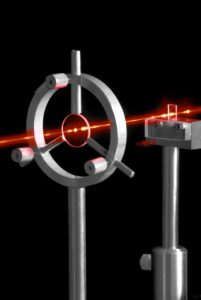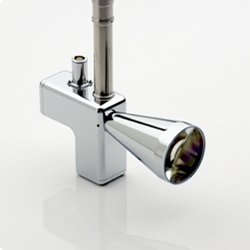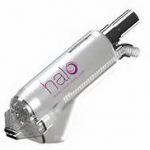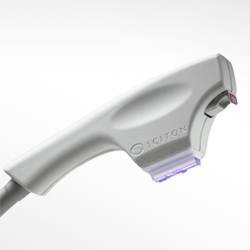Laser Surgery
Laser Cosmetic Surgery
Dr. Barry Eppley, has helped numerous patients by providing state-of-the-art laser surgery to correct a variety of aesthetic skin conditions such as wrinkles and discolorations.
THE HISTORY OF LASERS IN PLASTIC SURGERY
 The development and introduction of laser technology into medicine and surgery in the early 1980s caught the attention of the media and public alike. Great claims including increased speed of procedures, bloodless surgery, and leaving no scars has always accompanied the use of the word laser when combined with surgery. Unfortunately, much of this early hype, which continues to be believed even today, is inaccurate and misleading. The first surgical lasers introduced were only useful for cutting tissue and, while they were effective for that purpose, often resulted in slower healing of tissues and no real improvement in postoperative scars (often they were worse).
The development and introduction of laser technology into medicine and surgery in the early 1980s caught the attention of the media and public alike. Great claims including increased speed of procedures, bloodless surgery, and leaving no scars has always accompanied the use of the word laser when combined with surgery. Unfortunately, much of this early hype, which continues to be believed even today, is inaccurate and misleading. The first surgical lasers introduced were only useful for cutting tissue and, while they were effective for that purpose, often resulted in slower healing of tissues and no real improvement in postoperative scars (often they were worse).
LASERS IN PLASTIC SURGERY – WHAT CAN THEY TREAT?
In the past decade, the real benefits of laser technology has come to fruition for many previously untreatable problems. The explosion in laser technology and the use of certain laser wavelengths for specific problems has revolutionized many plastic surgical procedures. Today, the laser offers great benefits for port wine stains (facial purple marks), telangectasias (facial and leg spider veins), brown spots (age spots and light brown birth marks), facial line and wrinkle reduction, certain skin growths (e.g., papillomas, actinic keratoses), tattoo removal as well as hair reduction.
Laser Resurfacing and Fractional Laser Treatment
 One of the most recognized uses of lasers in plastic surgery is to resurface the skin to reduce wrinkles and texture irregularities (such as acne scars). When laser skin resurfacing was introduced in the 1990s, it was an ablative form… meaning that a certain amount of the outer skin surface was removed and allowed to heal. While very effective at skin rejuvenation, it resulted in long healing times and the risk of loss of some skin pigment. To reduce these concerns, laser resurfacing has evolved to a fractional concept where just a fraction of the skin is treated but with deeper channels cut into it. Much like ‘aerating the lawn’, a fractional laser approach heals faster, has little risk of loss of skin pigment and helps stimulate collagen production in the skin.
One of the most recognized uses of lasers in plastic surgery is to resurface the skin to reduce wrinkles and texture irregularities (such as acne scars). When laser skin resurfacing was introduced in the 1990s, it was an ablative form… meaning that a certain amount of the outer skin surface was removed and allowed to heal. While very effective at skin rejuvenation, it resulted in long healing times and the risk of loss of some skin pigment. To reduce these concerns, laser resurfacing has evolved to a fractional concept where just a fraction of the skin is treated but with deeper channels cut into it. Much like ‘aerating the lawn’, a fractional laser approach heals faster, has little risk of loss of skin pigment and helps stimulate collagen production in the skin.
Laser Resurfacing – How Does It Work?
A laser beam at 2940 nm wavelength is delivered through a computer controlled device that automatically scans the area of facial skin being treated. The depth of the laser beam penetration can be controlled to make the skin resurfacing very light (micropeel, less than 100 microns) or deep (100 to 400 microns). There are two approaches to resurfacing: full field, and fractional. In full field resurfacing, the entire surface area of the skin is treated. A laser beam is scanned across the treatment area and precisely removes a layer of skin. The body will naturally replace the old, damaged skin that was removed, with a fresh, healthy layer. Treatments can range from shallow (which might be appropriate for eliminating fine lines, sun spots and tired-looking skin) to deep (which is often used to improve skin tone/texture and eliminate deep wrinkles, even in difficult areas like upper lip lines and crow’s feet). In fractional resurfacing, the laser removes pinpoint columns of skin, leaving the surrounding tissue intact. This approach allows the laser to controllably ablate and coagulate tissue to variable depth, while the surrounding intact tissue promotes rapid healing.
Laser Resurfacing for Acne Scars
Acne is a hormonal disorder that affects the skin’s oil glands, sweat glands and hair follicles. Propionibacterium acnes are the bacteria that causes acne. Severe acne can lead to permanent scarring with a variety of skin defects from pits to shallow broad scars. Skin resurfacing of acne scars at a 2940 nm wavelength can help reduce the appearance of these scars in the properly selected patient. A fractional laser treatment does not ‘wipe away’ the scars as many think but works through the wound-healing process which produces fibroblasts that generate new collagen, plumping the skin and correcting skin imperfections.
HALO Hybrid Fractional Laser Resurfacing
 Laser resurfacing has evolved over the past decade into two treatment options. Ablative fractional laser treatments which involves fewer sessions and more downtime or fractional laser treatments that have more sessions but less downtime. The newest laser resurfacing technology is the now the HALO which combines both ablative and fractional treatments into a combined or hybrid laser. HALO is the world’s first hybrid laser resurfacing device that allows the patient to get ablative-like skin results with non-ablative down times.
Laser resurfacing has evolved over the past decade into two treatment options. Ablative fractional laser treatments which involves fewer sessions and more downtime or fractional laser treatments that have more sessions but less downtime. The newest laser resurfacing technology is the now the HALO which combines both ablative and fractional treatments into a combined or hybrid laser. HALO is the world’s first hybrid laser resurfacing device that allows the patient to get ablative-like skin results with non-ablative down times.
The HALO laser works by delivering 2940nm Er:YAG ablation energy (up to 100 microns) to the epidermis as well as 1470nm energy coagulation (between 100 and 700nm to the epidermis and dermis. This creates an unprecedented ability to deliver separate laser treatments to the skin at the same time to the same area. And it doe so with less downtime for the patient which is key.
Patients treated with HALO have been shown to have a much better skin appearance in both texture and pigment improvement as well as improvement in pore size and number than with any other laser technology. Of equal importance is that they are able to do so with only 1 to 2 HALO treatments compared to 5 or 6 other types of traditional later treatments.
HALO laser treatments on the face and neck produce significant skin appearance improvement with little to no side effects. Patients that have received previous ablative laser treatments prefer the healing experience with HALO. They are more comfortable afterwards, have no pinpoint bleeding spots, can wear makeup the next day and have a shorter duration of peeling. HALO sets the standard for what facial laser resurfacing should be.
PULSED LIGHT THERAPY
 Often confused with lasers, pulsed light offers many beneficial effects for skin as well. While lasers are focused (collimated) and very high intensity light, pulsed light is non-collimated and of lower intensity. But using various filters on a pulsed light device, skin conditions that have color (brown spots, red spots, hair) can be effectively treated.
Often confused with lasers, pulsed light offers many beneficial effects for skin as well. While lasers are focused (collimated) and very high intensity light, pulsed light is non-collimated and of lower intensity. But using various filters on a pulsed light device, skin conditions that have color (brown spots, red spots, hair) can be effectively treated.
Skin Tightening with Pulsed Light
Pulsed light can also be used for skin tightening (Skin Tyte) by heating up the underside of the skin, causing it to contract and tighten. Using one of the highest intensity pulsed light devices available, BBL (broad band light) provides the most effective form of pulsed light therapy currently available. SkinTyte utilizes infrared energy to deeply heat soft tissue while protecting the entire treated area with sapphire contact cooling. Targeted heating causes soft tissue coagulation and collagen contraction. This process initiates the body’s natural healing process, resulting in a firmer, more youthful skin appearance. The full effect of skin firming treatments can be seen with a series of treatments done over a few months of treatment time.
Before Laser Treatments
An evaluation of the skin problem in question is initially done to determine if a specific laser wavelength or pulsed light would be most effective. All pulsed light and most laser treatments are done in the office using either topical anesthetics or the chilled hand pieces of the treatment devices. In some facelift surgeries, laser resurfacing is done at the same time in the operating room.
Laser Surgery – The Procedure
All laser procedures are performed as an outpatient in either an office or surgery center setting. The majority of laser treatments can be done under topical anesthesia. Some deeper laser resurfacing may require supplemental oral sedation. Those laser resurfacing procedure done with facelifts are performed during the surgery under a general anesthetic.
In isolated target-specific laser treatments (such as brown spots, tattoos, and small blood vessels), the area is treated with the laser and works by the intended target tissue absorbing the very specific light and being destroyed in the process. This may create a scab (char) or discoloration over the treated area. Antibiotic ointment or a light gel dressing is applied at the end of the procedure and is all the postoperative dressing that is usually needed.
In facial laser resurfacing, the skin is treated by multiples passes with the laser (CO2) which removes (burns off) the top layers, helping to soften or eradicate wrinkles and superficial skin irregularities. As it is essentially a burn injury, care must be taken to not go too deep or injure the eye. Less deep laser skin resurfacing is now also available which can be done in the office under topical anesthesia. Multiple treatments are needed, every 3 months, to get the best skin result.
Laser Surgery – After The Procedure
After most laser procedures, pain and swelling is only moderate in severity. Certain laser procedures (e.g., removal of port wine stains, spider veins) are associated with a dark bruising after surgery which will take several weeks to resolve before the degree of lightening can be seen. In brown spots and tattoos, a scab (char) may occur which will fall out in about a week. In facial laser resurfacing, it is extremely important to keep all treated areas copiously moisturized with an antibiotic or other non-drying ointments after surgery until the skin has healed (week to 10 days). Thereafter, the skin should be kept well-moisturized until the pinkness of the skin fades (weeks to months dependent upon the type of resurfacing laser used and the depth of treatment performed).
The most important concept to know before one considers laser surgery is that there is no magic in the laser. While the laser does offer treatment of certain problems that may not have been previously treatable, they are not simply ‘point and shoot’ devices that always completely cures the problem that is being treated. Most commonly, laser devices offers some improvement and multiple treatments may be needed to achieve their maximal effect.

North Meridian Medical Building
Address:
12188-A North Meridian St.
Suite 310
Carmel, IN 46032
Contact Us:
Phone: (317) 706-4444
WhatsApp: (317) 941-8237
